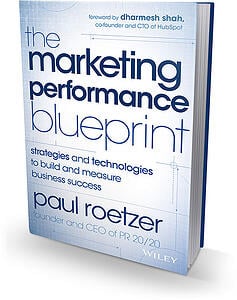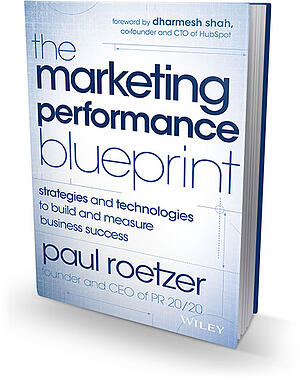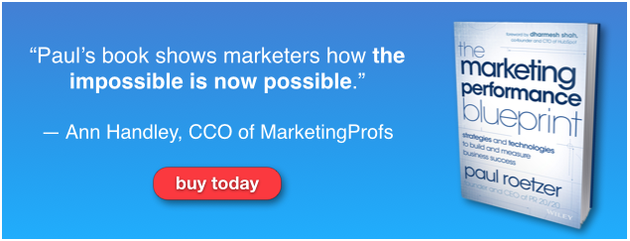“Marketing is now, as it has always been, an art form. But the next generation of marketers understands it can be so much more. These innovators are rewriting what is possible when the art and science of marketing collide.”
[The Marketing Performance Blueprint is now available in print and digital. Visit the book site to learn more.]
 The future of your business and your marketing career depend on your ability to meet increasing ROI demands and continually adapt to new marketing tools, philosophies, and channels. But the rate of change in the marketing industry is accelerating, and the challenges for marketers seem to be multiplying.
The future of your business and your marketing career depend on your ability to meet increasing ROI demands and continually adapt to new marketing tools, philosophies, and channels. But the rate of change in the marketing industry is accelerating, and the challenges for marketers seem to be multiplying.
The marketing talent pool is underprepared, the marketing mix is evolving, and the matrix of technology providers is exploding. Customers are tuning out traditional marketing methods, while consuming information and making buying decisions on mobile phones, tablets, computers, smart televisions, and wearable devices. Marketers are drowning in data, dealing with the complexities of real-time marketing, and navigating brands through the openness and transparency inherent to social media.
Yet, there has never been a better time to be a marketer.
Think about the possibilities.
- Every action and interaction can be measured and connected to outcomes.
- Marketing software can eliminate wasted resources, improve productivity, and enhance performance.
- Websites can dynamically alter content at an individual visitor level based on historical behavior.
- Email communications can be automated and personalized.
- Leads can be scored and nurtured to assist sales and maximize conversion rates.
- Brands can gain unparalleled insight into consumer behavior, build publishing platforms to engage audiences, and adapt campaigns and budgets in real time based on performance.
In short, marketing can be more intelligent, measurable, and powerful. It can be an asset, not an expense.
But change is not easy, and businesses of all sizes face an uphill battle.
Build a Performance-Driven Organization
“This is a book about what is possible. It is about unlocking your potential as a marketer and accelerating success for your organization.”
At its core, The Marketing Performance Blueprint is a story about the convergence of marketing talent, technology, and strategy. The bookpresents the processes, technologies, and strategies to fill marketing gaps and build performance-driven organizations. It is a guide for marketers, executives, and entrepreneurs to advance their businesses, exceed ROI expectations, and outperform the competition.
The Marketing Performance Blueprint shows how to:
- Align marketing talent, technology, and strategy to reach performance goals.
- Drive digital marketing transformation within your organization.
- Recruit, train, and retain a modern marketing team.
- Propel growth through digital-savvy marketing agency partners.
- Adapt more quickly to marketing technology advancements.
- Create connected customer experiences.
- Turn marketing data into intelligence, and intelligence into action.
- Devise integrated marketing strategies that deliver real business results.
Key findings and insights from dozens of industry reports, articles, books, and interviews are woven into The Marketing Performance Blueprint, along with analysis of in-depth marketing assessments from hundreds of marketers, executives, and entrepreneurs. I draw on my personal experiences consulting for hundreds of organizations, from startups to Fortune 500 companies, and mix in lessons learned as a marketing agency owner. My goal is to give you the resources and tools to advance your marketing career
In addition to the wealth of information outlined in the book, The Marketing Performance Blueprint includes downloadable worksheets as part of the Marketing Performance Pack. This handy resource complements the book and features a collection of templates, including a marketing team skills assessment, scorecard, campaign center, and project center.
Visit The Marketing Performance Blueprint website to read endorsements from Jay Baer, Brent Beshore, Scott Brinker, Andrew Davis, Ann Handley, Mitch Joel, Jeffrey Rohrs, and Mike Volpe.
Inside the Book
SECTION I: THE BACKSTORY
Chapter 1: Mind the Gaps
We Have Entered the Age of Content, Context, and the Customer Experience
Audiences crave knowledge, answers, and entertainment, while marketers strive to provide remarkable brand experiences that capture the hearts and minds of their prospects and customers. Leading brands have become storytellers, seeking to engage and influence audiences in a real-time, multiscreen world, at all phases of the customer journey.
Chapter 2: Commit to Digital Transformation
There Has Never Been a Better Time to Be a Marketer
The future of your business and your marketing career depend on your ability to meet increasing ROI demands and continually adapt to new marketing tools, philosophies, and channels. Marketers are drowning in data, dealing with the complexities of real-time marketing, and navigating brands through the openness and transparency inherent to social media. But marketing can be more intelligent, measureable, and powerful. It can be an asset, not an expense.
SECTION II: MARKETING TALENT
Chapter 3: Build a Modern Marketing Team
The Battle for Top Talent is Brewing
A marketing talent war has begun for tech-savvy, hybrid marketers who are capable of building, managing, and executing fully integrated campaigns that produce measurable results. These prototype marketers are able to deliver services across multiple marketing disciplines, including analytics, content, email, mobile, search, social, PR, and web. They are agile, adept at advanced marketing technologies, and experts at inbound strategy.
Chapter 4: Construct an Internal Marketing Academy
Businesses Must Take the Initiative to Mold Their Own Modern Marketers
As demand for performance-driven, digital-savvy talent rises, universities are struggling to prepare students for the reality of a rapidly changing industry. High performing companies find candidates at all levels with the necessary core competencies and traits (strong writing abilities, detail-oriented, analytical, strategic, curious, intrinsically motivated), train them through a blend of internal and external resources, and immerse them in marketing technology and strategy.
Chapter 5: Propel Growth through Agency Partners
The Marketing Industry Is Moving Too Fast to Internalize Everything
The marketing services industry is in a state of flux. As CMOs navigate the marketing talent gap, they are increasingly seeking performance-driven agency partners who are immersed in marketing technology and staffed with digital-savvy professionals. The right marketing agency can be a tremendous asset to your organization and play a critical role in propelling growth, but marketers must take a methodical approach to finding the right firms.
SECTION III: MARKETING TECHNOLOGY
Chapter 6: Create a Connected Customer Experience
The Customer Journey Is Personal and in Perpetual Motion
As fast as marketing technology is evolving, the consumer is the true change catalyst. Social networks, word of mouth, media outlets, bloggers, brands, and books influence consumer decisions, which are researched and made while jumping from smartphones to computers to tablets. The journey can be impulsive, with consumers making spur-of-the-moment purchases through apps and mobile sites, and it can be drawn out, with dozens of resources being referenced before major purchases are made.
Chapter 7: Manage the Marketing Technology Matrix
Modern Marketers Are Becoming Technologists
The rapid marketing technology evolution opens up endless possibilities for marketers and brands, but it also presents enormous challenges for marketers who already struggle to keep up with the rate of change.
SECTION IV: MARKETING STRATEGY
Chapter 8: Perform a Marketing Assessment
The Assessment Is a Marketing Strategy Gateway
Every marketing plan should start with an honest internal marketing assessment. The assessment should consider perspectives from multiple stakeholders, including marketing and sales leaders, as well as key executives. The strengths and weaknesses identified during the assessment process enable marketers to develop preliminary strategy concepts and begin to prioritize and allocate resources.
Chapter 9: Develop a Marketing Scorecard
Data without Analysis Is Simply Noise
Marketing executives and business leaders are drowning in data. They have access to powerful tools that produce endless streams of information about contacts, including visitors, leads, and customers. Your company must excel at bringing structure and meaning to numbers. Be proactive in assessing performance, and be willing to adapt in real time based on results (or lack thereof).
Chapter 10: Strategize a Marketing Game Plan
High Performers Connect Actions to Outcomes
The proliferation of marketing channels, apps, mobile devices, social networks, and content has given consumers more choices and greater control. Consumers want to be educated, enabled, and entertained, on their terms. Loyalty can be fleeting for brands that are not transparent and engaged. Companies must break through the clutter, connect with consumers, and create personalized experiences throughout the customer journey.
Free Download—Chapter 2: Commit to Digital Transformation
For a sneak peek, download a free copy of Chapter 2—“Commit to Digital Transformation.” The download includes the table of contents; foreword by Dharmesh Shah, HubSpot cofounder and CTO; and Chapter 2 in full.

%20Logo_BlueOrange_Trademark.png?width=800&height=269&name=Ready%20North%20(RN)%20Logo_BlueOrange_Trademark.png)




.jpg?width=300&name=Services%20Hub%203%20(3).jpg)




COMMENTS